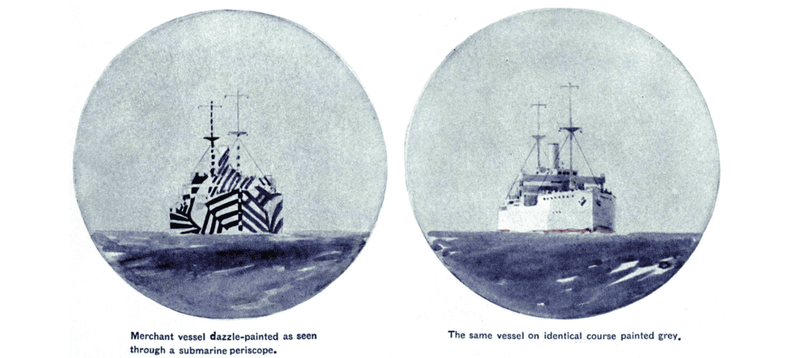DAZZLE CAMOUFLAGE DIDN’T HIDE SHIPS, BUT IT HELPED US WIN WWI

When the saying “give ‘em the ole’ razzle dazzle” was first uttered, they probably didn’t have in mind the subject that you’re here to read about today. Dazzle camouflage, also known as razzle dazzle camouflage, is a bit of a misnomer, as it didn’t really camouflage the ship in the way that traditional camo makes the wearer blend into their surroundings. It’s actually a lot more interesting than that, and it helped the Allies sail to success in WWI. Read next:Sink or Swim, the USS Texas Flooding Itself Was a Gamble That Paid Off
What Is Dazzle Camouflage?

Warfare History Network
Where Did WW1 Dazzle Camouflage Come From?
Razzle dazzle paint, another common term used for dazzle camouflage, is often credited to a British marine artist named Norman Wilkinson. Wilkinson was an artist from birth, and he spent a lot of his free time studying figure painting and working in poster design, oil and watercolor painting, and printmaking before moving on to marine subject matter. He went on to study art at the Southsea School of Art and at Portsmouth College of Art before becoming a teacher at the former. During his time abroad, he spent a lot of time studying ships and painting them, giving him a great understanding of the way they worked and moved and the perfect basis on which to develop the idea for dazzle camouflage ships. His life-saving art style didn’t come without those who would challenge Wilkinson’s ownership of it. One of the most prominent artistic minds of the time, and in the entirety of history, would come to claim at least partial ownership of razzle dazzle camo. Pablo Picasso, yes THAT Picasso, was the inventor of cubism, an art style that often used simple geometric shapes to include multiple views of the same subject on a singular dimension. This is, arguably, what happens with dazzle camo ships, given the irregular patterns utilized throughout to create an optical illusion. Picasso felt that, given his invention of cubism, he deserved some credit for the WWI invention. Though he’s only credited partially as an inspiration, his influence in the art world was still vital in making razzle dazzle camouflage a thing. Regardless of the credit or inspiration, this method of “camouflaging” ships was an amazing invention that saved lives.
Did Dazzle Camouflage Actually Work?
Yes! During WWI, the dazzle camouflage texture worked to great effect in confusing the enemy during naval warfare. After many other dubious and impractical ideas fell to the wayside, including covering ships with mirrors, disguising them as huge whales, and draping them in canvas to give them the appearance of clouds, Wilkinson’s innovation was put to the test. According to Smithsonian Magazine, Wilkinson had an epiphany that “Since it was impossible to paint a ship so that she could not be seen by a submarine, the extreme opposite was the answer – in other words, to paint her, not for low visibility, but in such a way as to break up her form and thus confuse a submarine officer as the course on which she was heading.” You see, for an Axis ship to be able to actually hit an Allied target on the seas, they had to have an accurate estimation of how far away they were, how fast they were going, and in which direction they were heading. As we’ve already discussed, the optical illusions created by the dazzle painted ships made it nearly impossible to get all these calculations right. Since German U-boats could generally only carry about 12 slow torpedoes on ship at once, it meant that they couldn’t afford to miss. If they did, they were in trouble. So, since they couldn’t get a good feel for where the enemy was, they often didn’t fire at all. If they did, it was usually a miss.
Why Did They Stop Using Ship Dazzle Camo?
WWI, which was the time in which the dazzle camouflage was used most extensively, lasted from 1914 to 1918. Though technology was impressive for the time, the effectiveness of dazzle camo could not outlast further military technological innovations. Upgrades in aircraft and radar rendered dazzle paint ships ineffective, as you could easily fly above a vessel to get a good understanding of everything you need to know to fire on it or use radar to do the same thing.
Modern Dazzle Camouflage
Though no longer utilized by the military, there are still some modern uses for razzle dazzle paint. Many auto manufacturers use the strategy, though not in the exact same way. When a new generation of a vehicle is being created, manufacturers must test the prototypes in a real-world environment, but, of course, they don’t want to spoil too much about them to the public. Thus, they use a dazzle camouflage car version of their prototype, so no one gets a good gist of what manufacturer the car is from or what trim it is. In its modern use, dazzle camouflage may not say lives, but at least its memory is being kept alive. Though dazzle camouflage is no longer in use in the military, we can all still appreciate its effectiveness at the time and the fact that it saved lives and contributed to an Allied victory in WWI. Read next:Vanilla or Chocolate? The WWII Ice Cream Ship Delivered Sweets at Sea



